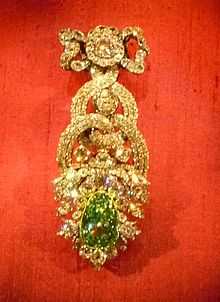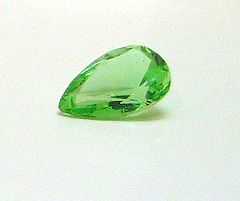Dresden Green Diamond
 The diamond in its hat clasp ornament | |
| Weight | 41 carats (8.2 g) |
|---|---|
| Color | Natural green |
| Country of origin | India |
| Date discovered | Before 1722 |

The Dresden Green Diamond, also known as "Dresden Green", is a 41 carats (8.2 g) natural green diamond, which probably originated in the Kollur mine in the state of Andhra Pradesh in India.
The Dresden Green is a rare Type IIa, with a clarity of VS1 and it is said to be potentially internally flawless, if slightly recut. [1]
It is named after Dresden, the capital of Saxony, Germany where it has been on display for most of the last two centuries. Today, the diamond is shown in the "New Green Vault" at Dresden Castle.
History
The Dresden Green Diamond has a historical record dating back to 1722, when a London news-sheet carried an article about it in its 25 October-27th edition.[2] It was acquired by Augustus III of Poland from a Dutch merchant in 1742 at the Leipzig Fair.[2] In 1768, the diamond was incorporated into an extremely valuable hat ornament, surrounded by two large and 411 medium-sized and small diamonds.[3] This is the setting that the Dresden Green still appears in today.
In 2000, American jewelry firm Harry Winston arranged to display the Dresden Green at the New York flagship store and then at the Smithsonian in Washington DC, USA, where it was displayed in the Harry Winston pavilion next to the largest blue diamond in the world, the Hope Diamond.
Color
The stone's unique apple green color is due to natural exposure to radioactive materials, as the irradiation of diamonds can produce changes in color. The Dresden Green Diamond has been used to compare natural versus lab-produced green diamonds — it is hoped that it can be used to devise a test to differentiate between naturally green diamonds, which are quite rare, and lab-produced ones.
References
- ↑ Famous Diamonds: Dresden Green
- ↑ 2.0 2.1 Edwin W. Streeter (1898). Dresden Green Diamond, in "The Great Diamonds of the World". George Bell & Sons. Retrieved 30 October 2011.
- ↑ Dirk Syndram, Prunkstücke des Grünen Gewölbes zu Dresden, 5th ed. Leipzig: Seemann, 2006, ISBN 978-3-86502-150-2, pp. 166-173 (German)